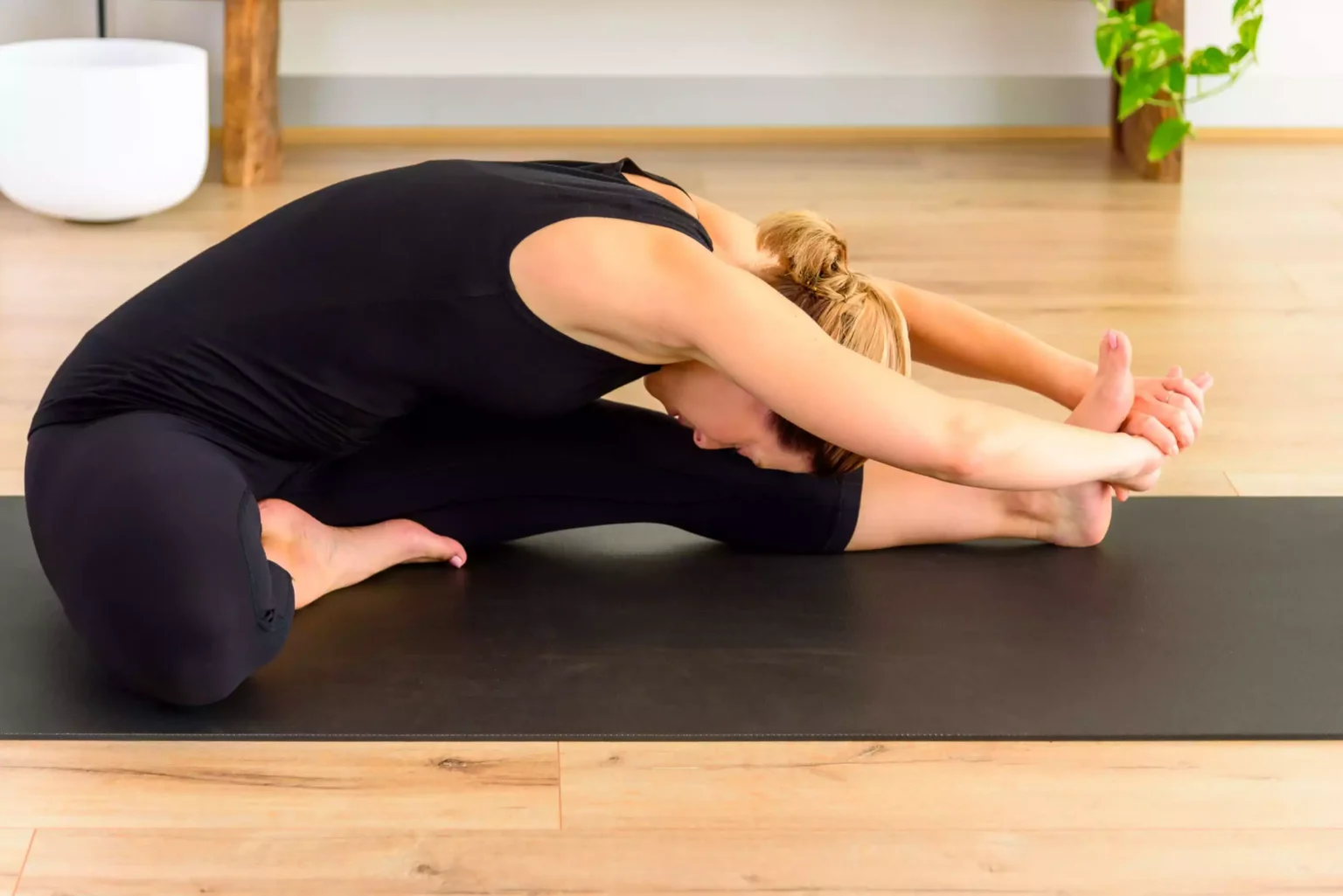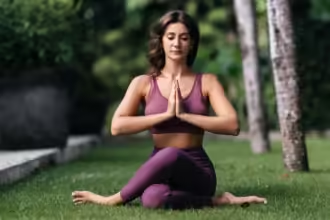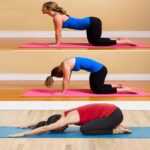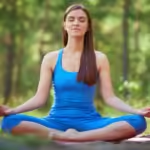Practicing yoga for anxiety and stress has many benefits in the long run. Both stress and anxiety are natural reactions to different life experiences. Whether it is situation of a conflict, diagnosis of a medical issue or loss of a loved one; stress and anxiety are natural to occur. A regimen of yoga helps you stay physically and mentally fit in the long run.
Unfortunately, too much of stress and anxiety in regular life takes a toll on your mental and physical health. You suffer from headaches, insomnia, depression, and a host of other medical issues. Yoga offers you a holistic way of life to get rid of these two issues without use of medications.
First, let us understand a bit in-depth about the way in which stress affects your body and mind.
Yoga for Anxiety and Stress – How Stress Affects You
Stress is your body’s natural mental and physical reaction towards certain life experiences. You are bound to feel stressed out owing to a hectic professional or personal life. The body responds to stress by releasing hormones which increase heartbeat and breathing.
Given below is how stress affects different parts of the body.
Nervous and Endocrine System
The central nervous system handles the fight or flight response of the body during stressful situations. During stress, the hypothalamus sends instructions to the adrenal glands to release adrenaline and cortisol, both of which are stress hormones.
Adrenaline and Cortisol escalate the stress level by increasing the heart beat and sending blood to muscles and other vital organs of your body. Practicing yoga for anxiety and stress helps you remain calm in chaos.
Digestive System
Your liver produces extra glucose under stress to maintain the body’s energy. Chronic stress leads to failure of body in keeping up with the extra glucose. You are at an increased risk of developing Type 2 diabetes under chronic stress.
Moreover, rapid breathing, and an increased heart rate upset the digestive system. You are more likely to suffer from a heartburn or acid reflux owing to increase in the stomach acid. Stress plays a major role in the way how food moves through the body and leads to constipation and diarrhea. Regular practice of yoga for anxiety and stress keeps the digestive system healthy and functioning.
Immune System
Under specific conditions stress helps as it stimulates the immune system. The stimulation assists in avoiding infections and healing wounds. However, the same hormone also leads to weakening of the immune and defense systems in the body. With regular practice of yoga for anxiety and stress you can easily work out stress without much issue.
Respiratory and Cardiovascular Systems
Stress hormones make it harder for respiratory and cardiovascular systems to maintain normal functioning. Your breathing becomes faster in a rush to distribute oxygen-rich blood to the body. In case you suffer from breathing problems as Asthma or Emphysema then stress makes it worse.
The stress hormones also lead to constriction of blood vessels as it sends more oxygen to the muscles to provide more strength. Unfortunately, it increases the blood pressure. Make sure you inculcate yoga for anxiety and stress in the exercise regimen to live a life free of unnecessary health issues.
Muscular System
During a stressful event the muscles often become tense to remain safe from any injury. Constant stress can decrease the ability of muscles to stay in a relaxed state. Too much tightness of the muscles cause headache, and other body aches. You should practice yoga for anxiety and stress to keep the mind and muscles in a calm state.
Reproductive System
Stress exhausts your body and mind. Short-term stress can help men produce more testosterone but it is not always the case. If you experience stress for an extended period of time then testosterone levels dip and it interferes with sperm production and cause impotence.
You should take out some time everyday to practice yoga for anxiety and stress to ensure each system inside the body functions to its best capacity.
Knowing how stress affects your body and mind is just the tip of the iceberg. Let us now understand how anxiety impacts your body and mind.
Yoga for Anxiety and Stress – How Anxiety Impacts Your Health
Anxiety is a normal part of everyone’s life. For example, you might feel anxiety when addressing a large group or giving an interview.
Feeling anxious increases both heart and breathing rate that sends more blood to the brain to prepare you for an intense situation. You might feel lightheaded and nauseous, not to forget it damages your physical and mental wellbeing.
You should know that a stressful situation in life can increase the risk of developing anxiety. First, let us understand the different forms of anxiety.
Generalized Anxiety Disorder (GAD)
The GAD includes excessive anxiety without any logical reason. Generalized Anxiety Disorder comes into play when worrying becomes a part of your everyday life. An exercise regimen that includes yoga for anxiety and stress helps you fight anxiety without the use of any medications.
Post Traumatic Stress Disorder (PTSD)
You develop PTSD after going through a traumatic situation. Most common causes of PTSD anxiety often stem from situations of war, natural disasters, and physical attacks. You should practice yoga for anxiety and stress to deal with this issue.
Obsessive Compulsive Disorder (OCD)
With OCD you feel compelled to perform certain actions time and again. It includes unnecessary thoughts and obsession with specific thought pattern. Common OCD symptoms include hand-washing, counting and checking things.
You develop aggressive impulses and obsession with cleanliness all the time. The yoga for anxiety and stress helps you stay free of any anxiety-related health problems.
Phobias
Phobias can include something as claustrophobia which is fear of enclosed spaces or fear of heights known as acrophobia. Practicing yoga for anxiety and stress helps you remain calm and fight the phobias.
Panic Disorder
Too much anxiety leads to panic attacks with feelings of impending doom. Some of the physical symptoms include heart palpilations, shortness of breath, and chest pain.
Social Anxiety Disorder
Social anxiety disorder causes a paralyzing fear of being judged and social situations. It can cause you to feel ashamed and alone. With regular practice of yoga for anxiety and stress you can overcome this unnecessary issue.
Needless to say that anxiety does a lot of damage to both body and mind. You suffer long-term damage to multiple systems inside the body.
Effects of Anxiety on Body
Let us understand how anxiety affects different parts of the body.
Central Nervous System
Suffering from long-term anxiety causes the brain to release stress hormones. It can cause an increase in headache, and depression. Adrenaline and Cortisol are the stress-inducing hormones that help you face a threat.
Unfortunately, long-term exposure to these hormones can cause you to gain unhealthy weight. Inculcate regular practice of yoga for anxiety and stress to keep the nervous system calm and focused in day-to-day life.
Excretory and Digestive System
Anxiety does a lot of damage to excretory and digestive systems. You would have issues as stomach ache, nausea, and a host of other digestive problems. Studies have shown a clear connection between anxiety and development of Irritable Bowel Syndrome or constipation. You should consider practicing yoga for anxiety and stress to help both the systems remain functional and healthy.
Respiratory System
Suffering from anxiety can cause rapid and shallow breathing. In case you suffer from Chronic Obstructive Pulmonary Disease (COPD) then there is a higher risk of hospitalization owing to complications arising from anxiety. The yoga for anxiety and stress prepares you to take control of breathing thereby reducing the chances of suffering from any respiratory problems.
Cardiovascular System
Anxiety can also lead to a rapid heart rate and chest pain. You are also at an increased risk of high blood pressure and other heart diseases. The regular practice of yoga for anxiety and stress help you in getting breathing in control along with a healthy heart.
Immune System
Anxiety often triggers the fight or flight response of the body that makes the brain flush the body with adrenaline to prepare you for a tense situation. In short term, it offers better pulse and breathing rate so the brain can get more oxygen.
However, if your body requires adrenaline on a regular basis then it does weaken the immune system in the long run. It makes the body open to viral infections and other health issues. Practicing yoga for anxiety and stress safeguards the digestive issues by calming down the mind with controlled breathing.
No need to be disappointed as with the problem also comes the solution. The yoga for anxiety and stress helps you get over everyday problems and maintain a calm composure in the long run. It is time you know how practicing yoga can help you life a life free of anxiety and stress.
4 Reasons How Yoga for Anxiety and Stress Can Help You Stay Calm
Given below are the four major ways in which practicing yoga for anxiety and stress in the long run.
Pranayama is the Key
Breathing is the first thing to do if you want to calm down the nerves. Both stress and anxiety cause shallow and fast breathing that only worsens both the conditions. Breathing exercises are of great help when it comes to dealing with the anxiety and stress in everyday life.
Given below are the three major breathing techniques under yoga for anxiety and stress.
i. Simple Breath Awareness
All you need to do is become aware of the breathing and how it flows. Make sure to focus more on the flow of the breathing without trying to control it and keep the mind focused to slow down pacing thoughts.
ii. Left Nostril Breath
Left nostril relates to right hemisphere of the brain and breathing activates the Ida Nadi which is the calming energy.
iii. Abdominal Breath
Abdominal breath keeps the body calm and nervous system free of any unnecessary stress and anxiety.
Meditation is Your Friend
Your mind would remain irritable and agitated under stress and anxiety. Meditation in yoga for anxiety and stress provides a calming effect to body and mind. The regular practice helps you become aware of the thought pattern. It helps you to let go of negative emotions.
Yogic Philosophy and Lifestyle is Worth It
Hectic lifestyle does play a vital role in increasing both anxiety and stress. The use of substances as alcohol and drugs adds on to the risk by changing the brain chemistry. Yoga helps you become more understanding and accepting of ourselves without judgment.
Practice of yoga helps you nurture the body with healthy and nutritious food and adapt to a healthy lifestyle.
Asanas Are Your Friend
Yoga helps you remain free of anxiety and stress by practicing specific asanas and relaxation. For example, specific asanas as child’s pose and Savasana help you control breathing and keep the mind focused on the present.
It goes without a doubt that practicing yoga for anxiety and stress can help you fight stress and anxiety in the long run.
Practicing yoga helps you not only stay mentally and physically fit but also safe from many health issues. Let us now look at some of the best yoga for anxiety and stress poses that you can practice to live a life of bliss.
Yoga for Anxiety and Stress – The Best Yoga and Pranayama Poses
Yoga helps you dive deeper into spirituality and unlock true potential with great physical and mental health.
First, let us check out the best yoga poses to help you live the best life.
Ustrasana (Camel Pose)
Ustrasana increases the flexibility of spine along with stimulating the nervous system. It also helps you expand chest and shoulders, not to forget it stimulates the thyroid. Practicing this yoga for anxiety and stress helps you relieve the stress and ensure proper circulation of blood throughout the body.
Bhujangasana (Cobra Pose)
The best yoga asana to strengthen the spine and stimulate abdomen and digestive system. The Cobra Pose helps you find relief from symptoms of stress including headache and fatigue.
Balasana (Child’s Pose)
If you are looking to find relief from neck, shoulder, and upper neck pain then Balasana is the best yoga for anxiety and stress pose. It helps you calm the mind and body through controlled breathing.
Setu Bandhasana (Bridge Pose)
An effective yoga pose for stretching the muscles of legs and back. It helps you increase blood circulation and also fight off sleeping disorders thereby reducing anxiety.
Ardha Matysyendrasana (Half Spinal Twist)
If you want to provide more strength and flexibility to the spine then practice the Half Spinal Twist yoga pose. The asana is helpful when it comes to dealing with back pain and stiffness. This yoga for anxiety and stress pose calms down the nervous system and keep the mind silent.
Now it is time to know a bit about the different Pranayama poses to fight anxiety and stress of daily life.
Yoga for Anxiety and Stress – Pranayama Poses for Better Health
Pranayama or the art of breathing helps you use the right technique while practicing yoga for anxiety and stress on a daily basis.
Yogendra Pranayama (Diphragm Breathing)
The best form of Pranayama when you want to keep the digestive organs healthy and functional. It provides improved breathing that helps you experience inner peace. It has a sedative effect that helps relax your nervous system.
Bhramari Pranayama (Bee Breath)
If you are looking to inculcate yoga for anxiety and stress in the daily routine; make sure you practice the Bee Breath that helps reduce blood pressure and headache. It provides instant calming effect on the mind and rids you of anxiety.
However, that is not all as yoga for anxiety and stress has much more to offer. Do you ever stop to wonder how you breathe during morning or before falling asleep? Yoga also offers some of the best breathing exercises to help you relax without the need for any additional equipment.
Yoga for Anxiety and Stress – Breathing Techniques
Deep breathing is the best way to lower the stress levels in the body. During a deep breath, the mind receives a message to stay calm and relaxed. The same message is sent to the body to keep the heart rate balanced, and decrease the chances of fast breathing.
With that said, let us now understand the three types of breathing patterns and how you can practice each to maximize the impact of yoga for anxiety and stress in daily life.
Belly Breathing
Belly breathing is the easiest one to practice and provides mind and body with complete relaxation. Given below are the steps to how you can practice this yoga for anxiety and stress breathing technique.
1) Sit or lie down flat in a comfortable position.
2) Put one hand on the belly right below the ribs and the other on the chest.
3) Now take a deep breath through the nose and allow the belly to push the hand out. Make sure to have no motion in the chest.
4) Next, breath through the pursed lips in a whistling motion. Push all the air out via the belly using your hand.
5) Repeat the breathing for at least 3 to 10 times. Take your time with each breath.
4-7-8 Breathing
This technique utilizes the belly breathing to help you relax and stay calm. Below are the guidelines to performing the breathing with precision.
1) Put one hand on the belly and the other on the chest just as you did with belly breathing.
2) Take slow and deep breath from the belly and count to 4 while breathing in.
3) Hold your breath and count slowly from 1 to 7.
4) Breath out slowly and try to get all the air out from the lungs.
5) Repeat the process at least 3 to 7 times.
Make sure to take note of how you feel at the end of this yoga for anxiety and stress breathing technique.
Roll Breathing
Roll breathing technique helps you fully use lungs and focus on the rhythm of breathing. The practice is best done lying on your back with knees bent. Read on to know how to perform this technique with precision.
1) Put the left hand on the belly and right hand on the chest. Notice the movement of the hands as you breath in and out.
2) Try to fill the lower lungs by breathing to make the belly go up when inhaling air. Make sure to breath in through the nose and breath out via mouth.
3) Make small whistling sounds with the right and left hand falling. As you exhale, let the tension leave the body and feel relaxed.
4) Practice the technique at least 8 to 10 times.
The Conclusion
Practicing yoga for anxiety and stress on a daily basis helps you keep both body and mind free of many health problems. Yoga offers you a holistic way to enjoy a life of bliss that is free of any medications or costly medical procedures.















